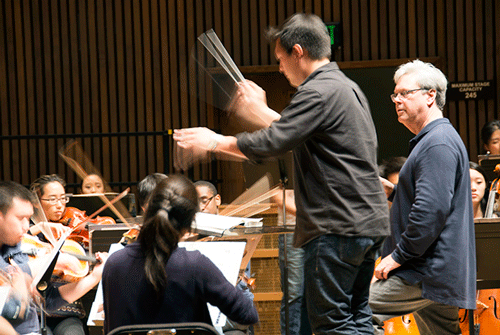Students pull the strings of the Summer Symphony
The Summer Symphony is back for its 27th season as student musicians run the shows.

July 24, 2015
For many UC Berkeley, students, summer means a break or time to earn some money. For others, it’s a season of opportunity for musical training, rehearsals, exploration and enjoyment.
And they’ll be performing next week, when the Department of Music will open the doors of Hertz Hall for the 27th annual UC Berkeley Summer Symphony, with free performances open to the public at 8 p.m. on Friday, July 31, and Saturday, Aug. 1. Donations are accepted.

Student conductor Nicholas Koo gets some help from David Milnes during a Summer Symphony rehearsal. (UC Berkeley photos by Hulda Nelson)
What began as a small chamber orchestra for student musicians from UC Berkeley and the immediate community has grown into a full-sized orchestra – with musicians from UC Berkeley and across the Bay Area – that performs major works from the standard classical repertoire.
Auditions occur over several days in early June, and rehearsals take place twice a week until the concert crescendo.
David Milnes, a UC Berkeley professor of music and director of the regular UC Berkeley Symphony Orchestra as well as the Berkeley Eco Ensemble, a new music ensemble in-residence, guides the Summer Symphony but pretty much lets the student musicians run the show.
“The experience provides a valuable learning opportunity for the student conductors, giving them first-hand experience in preparing a concert program, rehearsing an orchestra, and working with the administrative staff,” according to the Summer Symphony homepage. “In turn, the orchestra members have a chance to provide feedback while learning how to adapt to different conductors and styles.”
Milnes said the Summer Symphony is a local favorite, with a following akin to that of a baseball farm team whose fans keep tabs on the players as their careers progress.

The Summer Symphony features UC Berkeley student musicians as well as musicians from throughout the Bay Area.
The Summer Symphony can accommodate about as many players of stringed instruments as are interested, but only a limited number of woodwind and brass instruments, said Milnes.
As for student conductors, there are fewer slots still. The Summer Symphony conductors have all taken several of Milnes’ conducting classes, and he said they excel in terms of their drive, musical skills, knowledge of music history, organizational and leadership abilities, charisma and athleticism.
“The ones who want to do it are the ones who can do it,” he said.
Milnes said the Summer Symphony offers “an opportunity for student conductors to get their feet wet in a more relaxed atmosphere” before taking the next step in what most foresee as careers in conducting.
Taking the baton to conduct Shostakovich’s “Symphony No. 5,” Tchaikovsky’s “Romeo and Juliet Overture,” and Mussorgsky’s “Night on Bald Mountain” at Hertz Hall will be Jane Kim, Nicholas Koo and Stefano Flavoni, all of whom recently earned B.A. degrees in music.
“We’ve worked incredibly hard to get to this point and we’re not done yet; we’re still working hard,” Koo posted on his Facebook page. “This is an energetic and emotional set, and we’d love to have anyone and everyone to come and hear our music!”
Flavoni will begin a post as music director of the Shanghai Youth Choir in September. As a student, Flavoni conducted the Cal Marching Band and the University Wind Ensemble, and won the Eisner Prize in music, awarded for outstanding creative achievement in instrumental or vocal performance or in musical composition.
And, Milnes said, Kim, who has served as co-director of the UC Berkeley Chamber Orchestra and the Summer Symphony since graduating with double degrees in music and integrative biology, “is ready to go to the top-flight graduate school” to continue her conducting education.

Summer Symphony conductor Jane Kim, at a recent rehearsal.
Kim said she turned to conducting about four years ago after taking conducting courses, and was further entranced after “an amazing experience” conducting for the Summer Symphony about two years ago.
“There was a sensation of being enveloped in the orchestra sound, and that you have had a part in shaping the music … creating music together,” recalled Kim, who first learned to play the violin at the age of 4 and the piano at age 5.
Learning to be a conductor is essentially an eight-year process, like that of a professional school, Milnes noted. Several former student conductors of the Summer Symphony have gone on to private music conservatories such as Julliard, the Peabody and Manhattan School to polish their conducting skills.
While there are few women conductors of the top orchestras in the world, Milnes said about half the students in his conducting classes are female, and he expects the balance at the baton to shift soon. Kim agreed. She hopes to land an assistant conductor position or guest conductor jobs in the near future, and will be applying to graduate schools to continue her conducting education.
“Women conductors have been on the rise lately, and they’re still getting positions,” Kim said. While women in many fields find it harder to get a foot in the door, Kim said, that won’t stand in her way.
A map to Hertz Hall is online.